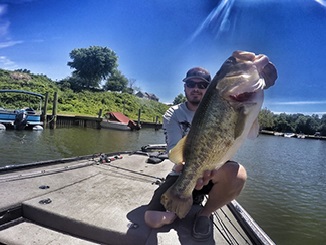 “A lot of anglers are a little fearful of fishing tidal waters,” said tournament angler and brand ambassador Ty Spade. “They think it’s confusing and that if the tide isn’t right, they won’t be able to catch fish.”
“A lot of anglers are a little fearful of fishing tidal waters,” said tournament angler and brand ambassador Ty Spade. “They think it’s confusing and that if the tide isn’t right, they won’t be able to catch fish.”
The angler, who counts Chesapeake Bay among his favorite tidal areas, admits they can be intimidating, but adds an angler’s attitude and approach can dissolve the mystique.
“Bass in tidal areas are just like fish in rivers. Their lives revolve around two things: spawning and the current,” Spade said. “They set up in a moving tide just like they do in a river, and most of the time the bite will be shallow. Best of all, the cover is so diverse, you can simply fish your strengths and be successful.”
Grassbeds, laydown trees, docks and pilings are found in just about every in tidal water up and down the coastline, and all tend to hold fish. Marinas filled with docks and pilings are among Spade’s favorite target areas.
“I like to flip a Booyah Bankroll Jig tipped with a YUM Christie Craw (black and blue),” Spade explained. “Most of the time, strikes comes on the fall because the soft plastic is hyper-lively — the perfect trigger for active, postspawn bass. But if it does hit bottom, the stand-up head keeps the bait upright.”
Casting a Double Willow Blade Spinnerbait parallel along the ends of the docks is another favored technique, and one that Spade used recently to catch the 7-plus-pound bass shown here. However, topwaters, such as a Pad Crasher, Boss Pop or Smithwick Devil’s Horse are good options, too, he adds.
Spinnerbaits and Pad Crashers are also productive around grass and trees, he says, along with the Booyah Swim’n Jig tipped with a Christie Craw or YUM Pulse swimbait.
“I like to stay in the more natural patterns—greens, yellow, sometimes white—with the Crashers,” he said, “and when you fish the Swim’n Jig, keep it moving. Twitch the rodtip or pause the retrieve like you would with a crankbait.”
If you been avoiding, or have been frustrated by, tidal waters, Spade recommends two actions that will lead to success: “First, just forget about the tide and fish areas you like to fish. Also, bring along a notebook and pencil. When you catch a bass, write down where you caught it, the time of day, and what the tide is doing (incoming, outgoing, strong, light, slack). At the end of the day you’ll know where the fish were and when they were there. After a couple of trips, patterns will emerge and very quickly you’ll begin to understand the different ways bass use the current — and most importantly — that the first hour before and the first hour after a slack tide is usually when bass are most active.”
One last bit of advice: Avoid muddy water. “It usually has some color to it, but if the wind blows and the water turns to chocolate milk, get out of there and fish somewhere else.”

